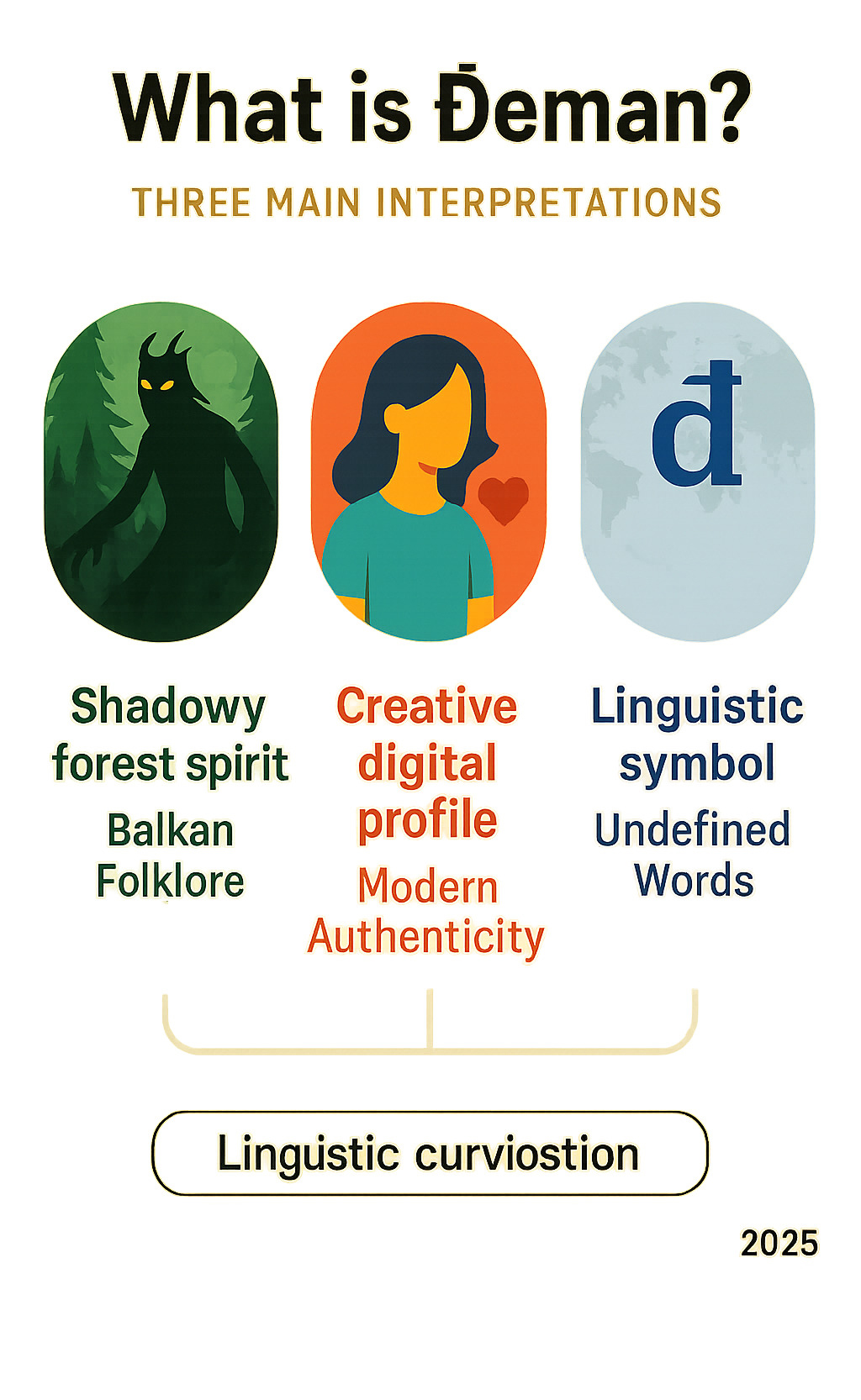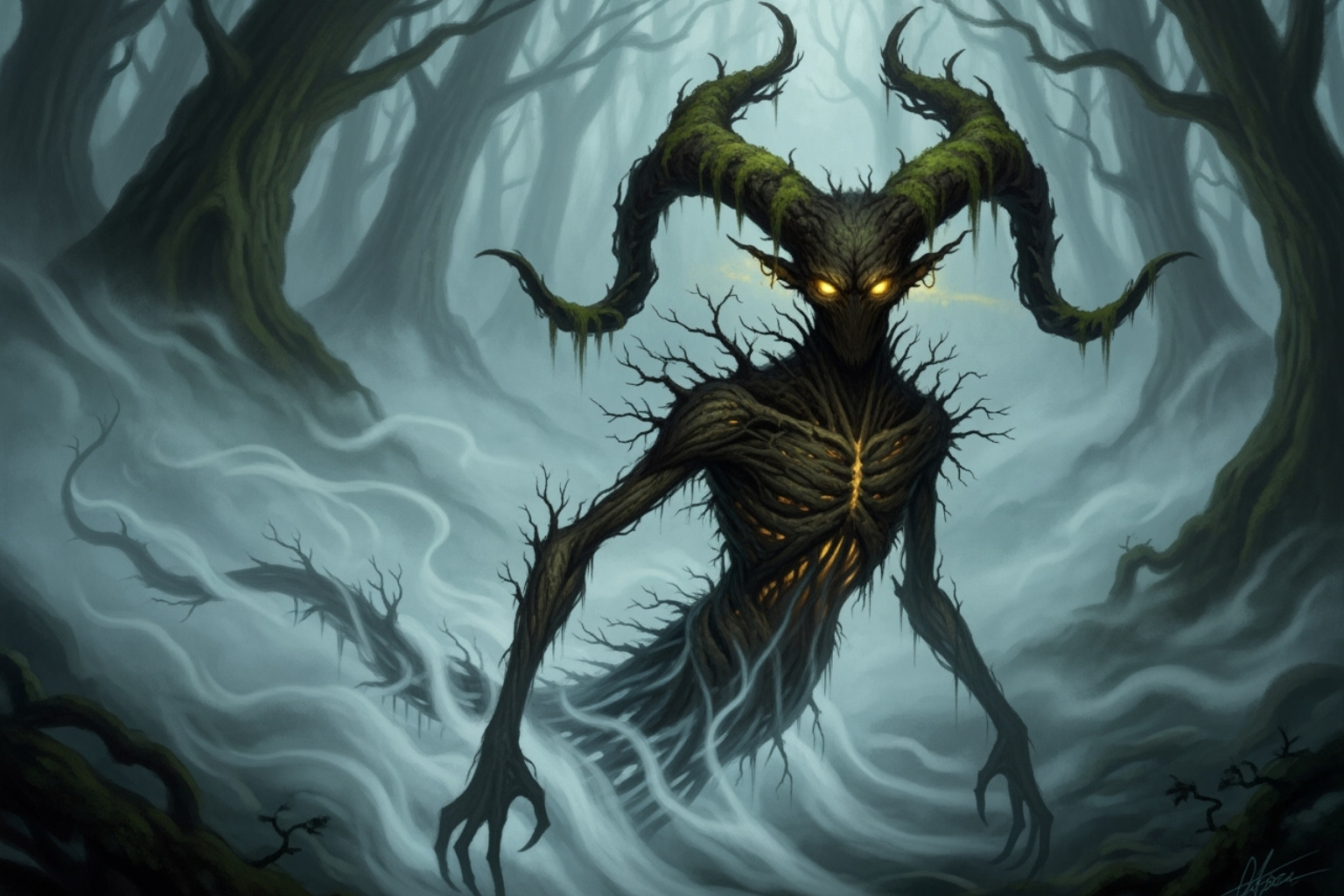What is Deman? Solving the Mystery

Deman sounds mysterious, and honestly, that’s because it is. This word has no single, official definition—making it one of the most intriguing terms you’ll encounter online.
Quick Answer for Searchers:
- No official dictionary definition exists for “deman“
- Three main interpretations: Balkan folklore spirit, modern digital identity concept, and linguistic curiosity
- The letter ‘d’ comes from South Slavic languages (Serbian, Croatian) and Vietnamese
- Often confused with Vietnamese “dem” (night) or “dem” (to count)
- Modern usage: Symbol of authenticity and creative digital expression
Here’s what makes Deman fascinating: it acts like a cultural chameleon. In Balkan folklore, it might represent a forest guardian or trickster spirit. In modern digital spaces, it’s becoming a symbol of authentic self-expression over polished perfection. Some use it as a creative username or artistic concept that breaks away from mainstream trends.
The word starts with ‘d’—a special letter found in languages like Serbian, Croatian, and Vietnamese. This gives it a unique phonetic identity that immediately catches attention. But unlike clear words with established meanings, Deman exists in the spaces between official definitions.
What’s particularly interesting is how this undefined word has found new life in our digital age. Content creators, artists, and wellness-focused individuals are drawn to its mysterious quality and use it to represent deeper, more authentic approaches to personal branding and creative expression.

Easy deman word list:
The Linguistic Facts: The Letter ‘D’ and Similar Words
Let’s explore the letter ‘d’—that unique character that makes deman so visually striking. This isn’t your everyday English letter, and that’s exactly what makes it special.
The letter ‘d’ appears primarily in South Slavic languages like Serbian and Croatian, as well as in the Vietnamese language. When you see it, you’re looking at a piece of linguistic history that connects cultures across continents.
In Vietnamese, the ‘d’ creates a sound similar to the English ‘d’ but with its own distinct flavor. In Serbian and Croatian, it produces what linguists call a voiced alveolo-palatal affricate—think of the ‘j’ sound in “jump” but softer. This unique pronunciation is why deman feels so intriguing when you first encounter it.
Why ‘deman’ is undefined becomes clearer when we understand how language works. Words don’t just appear in dictionaries overnight—they need time, widespread use, and official recognition. Deman might be a newly coined term, an artistic creation, or simply a concept that’s still evolving in digital spaces before linguists catch up.
Here’s where things get interesting with common confusions. Many people assume deman relates to Vietnamese words that look similar. The Vietnamese word ‘dem’ means “night,” while ‘dem’ means “to count.” There’s also a place called ‘Deman’ in Azerbaijan. They might sound alike, but they’re completely different words with their own stories.
| Term | Origin/Context | Meaning/Description |
|---|---|---|
| deman | Unofficial/Cultural | Multifaceted concept (folklore spirit, digital identity, linguistic curiosity) |
| dem | Vietnamese | To count; to number; to enumerate |
| dem | Vietnamese | Night; late night (after 9 PM) |
| Deman | Azerbaijan (village) | A village in the Yardymli Rayon of Azerbaijan |
The Origin of the Letter ‘D’
The story behind ‘d’ is pretty amazing. This voiced alveolo-palatal affricate might sound intimidating, but it’s just a fancy way of describing a specific sound that needed its own letter.
When languages like Serbian and Croatian adapted the Latin script, they needed ways to represent sounds that didn’t exist in standard Latin letters. The ‘d’ was their creative solution. It’s like creating a new tool when the old ones don’t quite fit the job.
In the Vietnamese alphabet, ‘d’ holds the fifth position and carries significant weight in daily communication. This phonetic identity helps Vietnamese speakers distinguish between words that would otherwise sound identical—crucial for clear conversation.
The presence of ‘d’ in deman immediately signals its non-English roots, adding layers of cultural depth and mystery that English speakers find captivating.
Verifying Word Meanings
In our information-rich world, knowing how to verify word meanings has become essential—especially for mysterious terms like deman. At Beyond Beauty Lab, we believe in empowering our community with solid research skills.
When you encounter an unfamiliar word, start with official dictionaries like Oxford English Dictionary or Merriam-Webster. These are compiled by professional linguists who follow strict standards for inclusion.
Academic journals and research papers offer deeper insights, particularly for cultural or specialized terms. University databases often contain linguistic studies that explore how words evolve and spread across communities.
Language authorities in different countries—like national language institutes—provide official guidance on usage and definitions. They’re the final word on what’s officially recognized.
The key is information literacy—the ability to distinguish reliable sources from speculation. With deman, we can be transparent about its unofficial status while exploring its cultural significance and creative applications.
This approach helps us distinguish fact from fiction without dismissing the real cultural impact that undefined terms can have in our digital age.
Deman in Folklore: The Balkan Spirit and Psychological Shadow
Step into the misty forests of Balkan folklore, and you’ll find Deman isn’t just a mysterious word—it’s a living, breathing presence in the stories passed down through generations. Unlike dictionary definitions, Deman exists in the field of whispered tales and flickering campfire shadows.
In Slavic and Balkan traditions, Deman emerges as a fascinating character that refuses to be pinned down. Sometimes it’s a guardian spirit, watching over ancient forests and sacred groves with protective eyes. Other times, it transforms into a trickster entity, leading unsuspecting travelers down winding paths that seem to go nowhere. The most intriguing aspect? Its ability as a shapeshifter—never quite the same from one story to the next.
These aren’t just spooky tales to frighten children. Each story carries moral lessons woven into its fabric. A greedy merchant who cuts down an old oak might find his cart wheels mysteriously breaking. A hunter who shows no respect for the forest could find his arrows always missing their mark. The Deman responds to human actions, teaching respect for nature and the unseen forces that surround us.

The Symbolic Meaning of Deman
Here’s where things get really interesting. The Deman of folklore isn’t just an external spirit—it mirrors something much deeper within ourselves. Psychologically speaking, Deman represents what Carl Jung called our shadow self—those parts of our personality we’d rather not acknowledge.
Think about it this way: when someone in a folktale encounters Deman, they’re often facing their own inner turmoil. The spirit’s mischievous nature reflects our internal struggles with temptation. Its unpredictable behavior mirrors our own suppressed emotions bubbling to the surface.
This psychological depth makes Deman incredibly relevant to our modern wellness journey. Just as we work on our external beauty routines, understanding and accepting these shadowy parts of ourselves is essential for true well-being. It’s about embracing the whole person—light and dark, perfect and flawed. For more insights on this journey of self-findy, explore our wellness practices.
In many cultures, Deman becomes a cultural scapegoat—something to blame when life gets complicated or when we make choices we later regret. But perhaps that’s exactly the point. Sometimes we need an external symbol to help us process internal complexity.
Deman in Storytelling and Mythology
The Midnight Deman legend remains one of the most captivating tales in Southeastern European folklore. Picture this: a lone traveler walking through ancient woods as midnight approaches. The Deman appears—not always as a monster, but sometimes as a cryptic guide offering strange wisdom or leading the traveler toward an unexpected revelation.
These cautionary tales served practical purposes in village life. Parents would warn children about venturing near old wells or abandoned places at night, invoking Deman as both protector and potential threat. It was a way of teaching respect for nature while keeping curious youngsters safe from real dangers.
What makes these stories fascinating is their moral complexity. The Deman isn’t purely evil—it’s a reflection of human actions and intentions. Show respect for the forest, and it might guide you home safely. Approach with greed or disrespect, and you might find yourself wandering in circles until dawn.
These tales connect us to pre-Christian beliefs where spirits like Deman represented the untamed wilderness and the dual nature of existence itself. Through centuries of oral traditions, the stories evolved but never lost their essential truth: life is complex, nature deserves respect, and sometimes the most important lessons come from the shadows.
The enduring appeal of Deman in folklore shows how deeply we need symbols that can hold our contradictions—the trickster who teaches, the shadow that illuminates, the mystery that somehow makes perfect sense.
The Modern Revival of Deman: Authenticity in Digital Culture
In today’s world of carefully curated Instagram feeds and polished LinkedIn profiles, Deman has finded an unexpected second life. This ancient folkloric concept is being acceptd by a new generation of creators who are tired of digital perfection and hungry for something real.
The modern Deman movement isn’t about ancient spirits or forest guardians. Instead, it represents a refreshing approach to digital identity that values authenticity over algorithms. Think of it as the antidote to influencer culture—where showing your messy morning routine or sharing your skincare struggles becomes more valuable than another perfectly lit selfie.
This shift feels especially relevant in the beauty and wellness space. Just as we’ve moved toward clean beauty and holistic wellness practices, our online presence is also craving that same honest, unfiltered approach. The Deman ethos encourages us to share our real journey—the breakouts, the bad hair days, and the moments when our meditation practice consists of three deep breaths between meetings.

What makes this movement powerful is how it breaks stereotypes about online success. Instead of chasing viral moments, Deman-inspired creators focus on building genuine connections. They’d rather have 100 engaged followers who truly connect with their message than 10,000 who scroll past without thinking.
How to Embody the ‘Deman’ Ethos
Living the Deman philosophy online starts with embracing your authentic self. This means sharing authentic content that reflects who you really are, not who you think people want you to be. Maybe that’s posting your skincare routine on a day when your skin isn’t cooperating, or sharing the wellness practice that actually works for you—even if it’s not trending.
The beauty of this approach lies in finding your people—those niche audiences who genuinely care about your journey. When you stop trying to please everyone, you start attracting the right community. These connections often become deeper and more meaningful than surface-level engagement.
Community over virality becomes your guiding principle. Instead of creating content designed to go viral, you focus on sparking real conversations. You respond to comments thoughtfully, ask genuine questions, and create space for others to share their experiences. This approach often leads to the kind of loyal community that beauty and wellness brands dream of building.
For businesses embracing this ethos, marketing with meaning takes center stage. This means being transparent about your values, sharing the story behind your products, and connecting with customers on a human level. It’s about building trust through honesty rather than trying to convince through perfection.
The human-centered design aspect of Deman extends beyond social media into how we approach technology and innovation in beauty and wellness. It influences everything from creating more inclusive product lines to developing apps that actually support well-being rather than feed comparison culture.
Deman in Art and Media
In urban fantasy fiction, deman appears as a morally complex character—neither purely good nor evil, but something beautifully complicated that mirrors our own human experience.
Video games have acceptd Deman-inspired characters as mysterious guides or challenging adversaries that make players question their assumptions. The concept works perfectly in gaming because it represents the unknown—that thrilling uncertainty that keeps us engaged and curious.
In the independent music scene, particularly in electronic and ambient genres, artists adopt Deman as an artistic identity that represents authenticity over commercial appeal. It’s become shorthand for music that prioritizes emotional connection over chart success.
Visual arts and tattoo designs often feature Deman-inspired imagery—shadowy figures, mysterious symbols, or abstract representations that hint at hidden depths. These pieces resonate with people seeking art that reflects the complexity of modern life rather than simple, surface-level beauty.
Folk-horror podcasts and independent films draw on Deman‘s folkloric roots to create content that feels both ancient and utterly contemporary. They use this cultural touchstone to explore themes of authenticity, identity, and the masks we wear in digital spaces.
This artistic revival shows how ancient concepts can find new relevance when they speak to universal human experiences—like our desire to be seen, understood, and accepted for who we truly are.
Frequently Asked Questions about Deman
We know deman can feel puzzling at first—and honestly, that’s part of what makes it so fascinating! Here are the questions we hear most often from our community, along with clear answers to help you understand this mysterious concept.
What is the official meaning of ‘deman’?
Here’s the honest truth: deman doesn’t have a single, official definition that you’ll find in any standard dictionary. And that’s actually okay! Not every meaningful word needs to be officially recognized by language authorities.
Think of deman more like a cultural chameleon that changes meaning depending on who’s using it and why. In Balkan folklore, it might represent a forest spirit or guardian. In modern digital spaces, people use it to express authentic creativity and genuine self-expression. Some artists adopt it as a symbol of breaking away from perfectionist culture.
The beauty of deman lies in its flexibility. It’s a concept that grows and evolves with the people who connect with it, rather than being locked into one rigid definition.
Is ‘deman’ an evil demon?
Not at all—though we totally understand why people might think this! The similar sound to “demon” in English can be misleading, but deman in folklore is much more complex and interesting than that.
In traditional Balkan and Slavic stories, deman is usually portrayed as a morally gray figure. Think of it more like a trickster or nature guardian rather than something purely evil. These spirits might play pranks on disrespectful visitors, but they could also guide lost travelers or protect sacred places.
The key difference is that deman typically responds to how people treat it and the natural world. Show respect for nature and ancient traditions, and you might find it helpful. Act carelessly or greedily, and you might face some mischief. It’s less about evil and more about natural consequences and moral lessons.
How is the Vietnamese word ‘dem’ related?
While deman and the Vietnamese word ‘dem’ sound quite similar and both use that distinctive ‘d’ letter, they’re actually completely unrelated in meaning. It’s one of those interesting linguistic coincidences that can cause confusion.
‘Dem’ is a well-established Vietnamese word meaning “night”—specifically the time after sunset when darkness falls. It has clear historical roots tracing back through Proto-Vietic language and even older language families. Vietnamese speakers use it every day in phrases about nighttime activities, evening meals, or late-night conversations.
The connection is purely phonetic. Both words happen to start with that unique ‘d’ sound, but that’s where the similarity ends. It’s like how “night” in English sounds similar to “knight”—same pronunciation, totally different meanings and origins.
Conclusion: Embracing the Many Faces of Deman
Our exploration of Deman has taken us on quite a journey, hasn’t it? We’ve wandered through misty folklore paths, dove into linguistic mysteries, and finded how an undefined word can spark creativity in our digital age. What makes Deman so captivating is precisely what makes it elusive—it refuses to be pinned down to just one meaning.
Think about it: Deman exists simultaneously as a shadowy forest spirit in Balkan tales, a reflection of our own inner complexity through psychological symbolism, and a guide for authentic self-expression in our increasingly digital world. It’s like holding a prism up to the light—each angle reveals something completely different, yet equally beautiful.
This linguistic puzzle teaches us something profound about authenticity itself. Just as Deman can’t be reduced to a simple dictionary definition, we as humans are wonderfully complex beings who can’t be summarized in a single social media bio or reduced to surface appearances. The Deman ethos reminds us that our most interesting qualities often lie in our contradictions, our mysteries, and our willingness to accept all parts of ourselves.
At Beyond Beauty Lab, we see a beautiful parallel between the multifaceted nature of Deman and our approach to wellness. True beauty isn’t about fitting into a single mold or following someone else’s definition of perfect. It’s about honoring your complete self—your history, your quirks, your shadows, and your light. The journey of self-findy, much like understanding Deman, reveals new layers the deeper we go.
Whether you encountered Deman through folklore, stumbled across it in creative communities, or simply found yourself curious about this mysterious term, you’ve joined a tradition of people who appreciate complexity over simplicity. In a world that often demands quick answers and easy categories, Deman invites us to sit with mystery and find beauty in the undefined spaces.
Ready to continue your own journey of authentic self-findy? Explore more wellness insights with us, where we celebrate the beautiful complexity of being human—one thoughtful step at a time.






